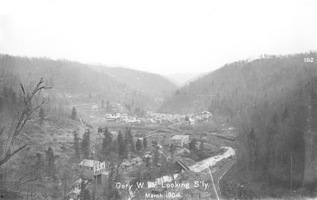 | Back to e-WV
| Back to e-WV
 The West Virginia Encyclopedia
The West Virginia Encyclopedia
 | Back to e-WV
| Back to e-WV
 The West Virginia Encyclopedia
The West Virginia Encyclopedia

The United States Coal & Coke’s sprawling McDowell County industrial complex known collectively as Gary was for half a century among West Virginia’s most productive coal mines. The model company towns making up Gary Hollow employed thousands of miners and shipped more than 200 million tons of high-quality ‘‘smokeless’’ fuel in its 54 years of full operation.
The creation of Gary marked the entry of J. P. Morgan’s U.S. Steel into southern West Virginia, when Bramwell banker I. T. Mann, with Morgan’s backing, exercised an option on prime coal-bearing land owned by the Norfolk & Western Railway’s Flat Top Land Association. Morgan’s company ultimately claimed a lease for more than 50,000 acres along Sandlick Creek of the Tug Fork and began constructing the huge works in 1901, designed to provide abundant high-quality coal and coke to the national industrial conglomerate. Thus, U.S. Coal & Coke was an affiliate of U.S. Steel.
Fully built, Gary Hollow contained 12 separate company towns, linked by paved roads and N&W rail spurs to the main company offices at No. 3 Works. The work force was highly diverse; a 1915 West Virginia Bureau of Mines report listed 1,479 hand-loading miners employed at Gary, with 227 white Americans, 271 African-Americans, 360 Hungarians, 224 Rumanians, 135 Italians, 145 Poles, and 117 miners of Slavic descent.
The nearly 15,000 West Virginians who inhabited Gary by the 1940s were served by 27 churches, ten company stores and three independent stores, three restaurants, nine elementary and two high schools, a clubhouse and athletic fields, a bowling alley, barbershop, pool hall, country club, bakery, dairy, and movie theater. The 1923 U.S. Coal Commission report awarded Gary 90 out of a possible 100 points for its cleanliness, urban amenities, and safety considerations.
Gary’s parent company eventually decided that the operation was no longer profitable and pulled out of Gary completely by the 1980s, after selling the homes to the remaining inhabitants and depositing its records in the Eastern Regional Coal Archives in the Craft Memorial Library in Bluefield.
Written by C. Stuart McGehee
McGehee, Stuart. Gary: A First-Class Operation. Goldenseal, (Fall 1988).
Clipping files. Hornick Collection & USX records, Eastern Regional Archives.